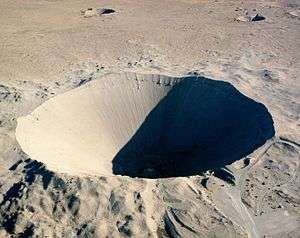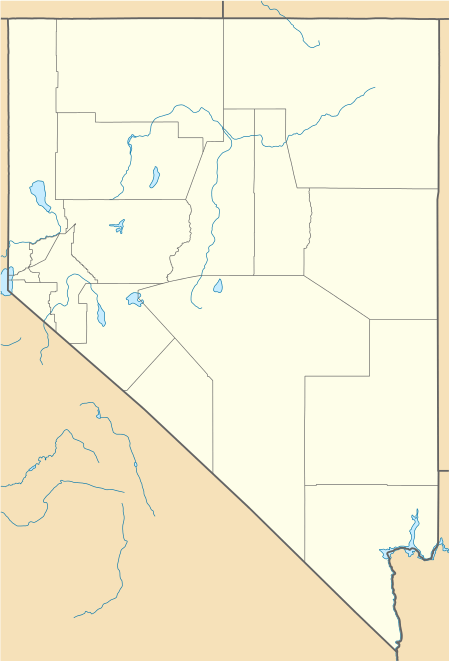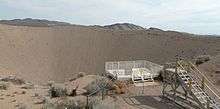Sedan Crater
Sedan Crater is the result of the Sedan nuclear test and is located within the Nevada Test Site, 12 miles (19 km) southwest of Groom Lake, Nevada (Area 51). The crater was listed on the National Register of Historic Places on March 21, 1994.[1][2]
Sedan Crater | |
 The Sedan crater | |
 | |
| Location | Area 10, Nevada Test Site |
|---|---|
| Nearest city | Mercury, Nevada |
| Coordinates | 37°10′36″N 116°2′48″W |
| NRHP reference No. | 94000183 |
| Added to NRHP | March 21, 1994[1] |
The crater is the result of the displacement of 12,000,000 short tons (11,000,000 t) of earth.[3][4][5] Over 10,000 people per year[6] visit the crater through free monthly tours offered by the U.S. Department of Energy, National Nuclear Security Administration Nevada Site Office.[5] Its closest Soviet counterpart is the slightly wider Chagan crater which filled in to create Lake Chagan.
History and description
The 1,280 by 320 ft (390 by 100 m) crater was created on July 6, 1962 by a 104-kiloton-of-TNT (440 TJ) thermonuclear explosion.[5][3] The device was buried 635 feet (194 m)[3] below the desert floor in Area 10 of Yucca Flat and was the largest cratering shot in the Plowshare Program. The explosion created fallout that affected more US residents than any other nuclear test, exposing more than 13 million people to radiation.[7] Within 7 months of the excavation, the bottom of the crater could be safely walked upon with no protective clothing and photographs were taken.[8]
Because the craters at the Nevada Test Site (NTS) have features similar to the topography of Moon craters, 11 of the 12 American astronauts who walked on the moon trained in Nevada before their missions.[9]
Russian thistle, also known as tumbleweed, is the primary plant species along with some grasses. Analysis in 1993 observed that the original perennial shrubs once living there had shown no recovery.[10]
Statistics

See also
- Barringer crater
References
- Furlow, Robert C. (October 5, 1993). "Sedan Crater". National Register of Historic Places Registration Form. National Park Service. Retrieved May 25, 2009.
- "Photos – Underground Nuclear Testing – Nevada Test Site". Nevada Division of Environmental Protection. Archived from the original on November 16, 2008. Retrieved November 29, 2010.
- Information sign at the crater:
- "Sedan Crater". KNPB. Archived from the original on July 15, 2008. Retrieved November 29, 2010.
- "Nevada Test Site Tours". US Department of Energy. Archived from the original on February 19, 2015. Retrieved January 27, 2015.
- Nevada Test Site History. Sedan Crater Archived November 12, 2008, at the Wayback Machine
- All Around Nevada with a 360 image
- "Possibilities for peaceful nuclear explosions. An IAEA review of the 1968 book: The constructive uses of nuclear explosions by Edward Teller" (PDF). Archived from the original (PDF) on March 20, 2015.
- Henry Brean (July 19, 2009). "Nevada Test Site gave astronaut trainees taste of lunar landscape". Las Vegas Review-Journal.
- Sedan Crater at Nevada Online
- Project Sedan, On-Site Radiological Safety Report
External links
| Wikimedia Commons has media related to Sedan Crater. |
- Sedan Nuclear Test- Original Military Film - YouTube
- Nevada National Security Site History - Sedan Crater (PDF)
- The Nuclear Sedan Crater of Nevada
